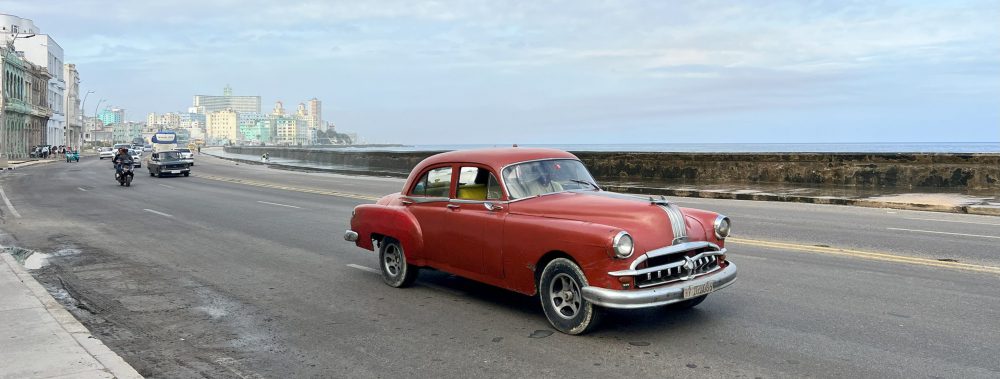The morning began with the call of roosters on the street. Breakfast at our residencia was the typical fresh banana and papaya, served with eggs, toast, coffee, and fresh mango juice. At 9:00 am, the fifteen of us gathered onto our Transtur bus, akin to a tour bus or coach bus service in the US. From there we were driven through the bustling streets of Havana over roads of pavement, dirt, and stone bricks. Our driver attempted to obey the imaginary lanes as we passed cars made in the 1960s, some with no windows or side mirrors. Despite the lack of automobile safety and up to date infrastructure, the people of Havana laughed and conversed on the haggard sidewalks, feeding the neighborhood dogs, and buying fresh fruit from permit-less stands.
As our bus pulled up to the San Jose Art Fair, we entered what resembled a hollowed out mill building or parking garage, now occupied by hundreds of stalls filled with handmade jewelry, paintings, and crafts. Some of the art included paintings of Mickey Mouse holding a Cuban cigar and stickers of the Apple logo with a Cuban flag- an obvious and humorous attempt to appeal to Americans.
From the instant we entered the market, we were bombarded with “holas” and “buenos dias”. We quickly realized it was impossible to walk more than 10 steps without being ushered into a stall by an artist. You couldn’t get a word out before they began to elaborate on their merchandise and prices. Beautiful paintings that could have sold for hundreds of dollars in America were being sold for $10-$30 USD. Ornate, handmade trinkets and decorated clay mugs were going for $5 at the most. There was more art than you could imagine. We could have spent an entire day there wandering the stalls and admiring it all.
I kept joking to the artists that we were very popular there. In reality, their urgency was primarily a reflection of the suffering economy and lack of tourism due to America’s 62-year trade embargo, referred to by Cubans as “el bloqueo”, the blockade. Despite our government’s harsh sanctions that leave most Cubans with no money to spare, we were greeted with smiles. I purchased many trinkets at the craft fair, including wooden bracelets, paintings of the Havana streets, and a hand-woven dress. Each purchase was met with gratitude from the seller, one of whom said he had not made a sale in 2 weeks.
Their desperation and our wealth enabled us to negotiate the prices of their goods. In a way, this was optimal for us, however I felt a twinge of guilt knowing these people earn $20-$40 a month and that they have spent decades perfecting their craft. My longest and most memorable interaction was with a woman who offered to braid my hair for $10. I agreed, and we engaged in basic conversation, which was possible due to my minimal Spanish vocabulary. I tipped her an additional 600 pesos- equivalent to $2-$4 USD after she showed me pictures of her young daughter. I handed it to her saying “En América, yo trabajo una hora para quince dinero. Es no mucho para mi,” or, “In America, I work 1 hour for $15. It is not much to me.”
After about an hour at the art fair, we departed for the town of Guanabo, about 20 minutes from Havana. There we set down our bags at a nearly complete beach house perched on the Caribbean Sea. It was one of the most beautiful views I have ever seen. I joked with the other students that if we pooled all our money together, surely we could afford the house. The woman hosting us had been constructing it for almost twenty years, hand laying the stones herself with a small team of workers. She intended to put it on the market soon for a mere $500,000.
We enjoyed a lecture from a Cuban marine biologist there, who informed us of the research and conservation she performs on the island. We learned about the importance of lagoons, mangroves, and coral reefs to the ecosystems. She explained that while Cuba has sufficient policies to protect the wildlife, and Cuban culture values the natural world, a lack of resources makes the laws hard to enforce. For instance, fishermen are prohibited from fishing in many protected areas around the island, however there are almost no ships to patrol and enforce these rules.
Following our lesson, we changed into swimsuits and took a dip in the ocean. The water was bright blue, and the air was a perfect 80 degrees. A man, who likely overheard our English and spotted us tossing a football, came over to sell us fresh coconut juice. After a seaside lunch of rice and beans, Caribbean lobster, and various fruits I don’t know the name of, we returned to our residencia for a late siesta.
On our first day in Havana, we were warned we would receive attention as Americans, which might be positive or negative. This day we were greeted by only smiles and “bienvenidos”. My knowledge of the Cuban economy and US’s sanctions made me more willing to buy from the locals at the art fair. I knew that my money would go much further for them than it would for me. I am not oblivious to the fact that some Cubans likely held resentment and distaste towards us due to the American government’s actions. However, our money as visitors from a developed world likely prevailed. I am glad that I was able to brighten the days of so many people with only a few dollars. In addition, I was blessed to experience the Cuban art scene and enjoy the beautiful landscape of the island.
Ainsley Skinner
